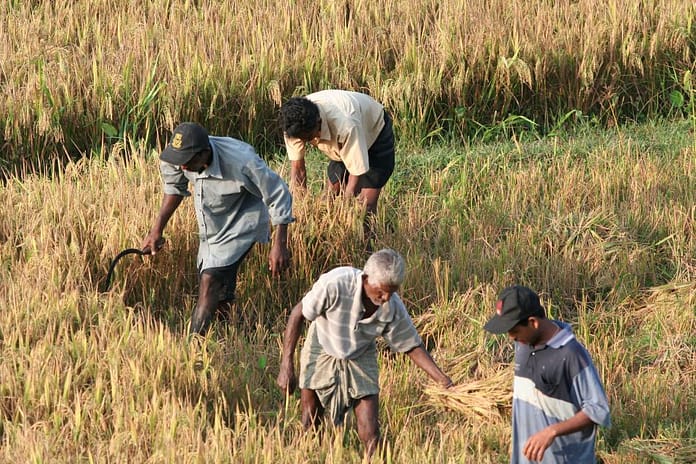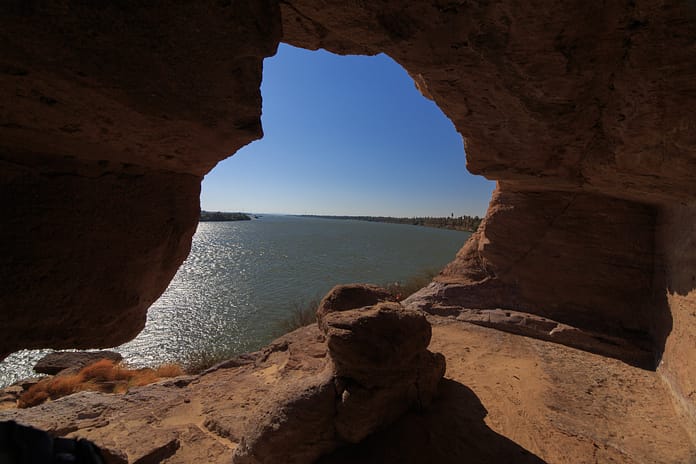By Maha Al-Zu’bi, Mansoor Leh, Youssef Brouziyne, Komlavi Akpoti & Naga Velpuri

Morocco’s Souss-Massa basin is grappling with water crisis, characterized by diminishing freshwater resources due to prolonged drought, extreme heat, and unsustainable water abstraction practices. This crisis threatens the region’s crucial agricultural production of cereals, vegetables, fruits, and nuts, impacting the livelihoods of half its workforce. The basin, bounded by the High Atlas Mountains to the north, the Siroua Massif to the east, and the Anti-Atlas Mountains to the south, encompasses a diverse network of rivers, aquifers, and both natural and human-made lakes across 27,000 square kilometers.
These freshwater resources are vital for the basin’s agriculture, which employs half of the region’s workforce and significantly contributes to Morocco’s GDP through agriculture, tourism, and fisheries. However, six consecutive years of drought and record-breaking heatwaves since 2019 have intensified pressure on water governance systems, challenging the equitable and sustainable management of both surface and groundwater resources across competing sectors.
A dashboard revolution
To tackle the pressing challenges of water scarcity in Morocco’s Souss-Massa basin, IWMI in collaboration with the Agence de Bassin Hydraulique de Souss Massa (ABHSM) co-designed an Online Water Accounting Dashboard which offers stakeholders a sophisticated, yet user-friendly visualization tool designed to monitor the current and future status and trends of water resources. The dashboard provides baseline data insights and future projections, enabling stakeholders to make informed decisions about water availability and use.
The tool is crucial for the sustainable and equitable management of the basin’s limited freshwater resources, as it enhances cross-sectoral governance by integrating information across various domains, including agriculture and industry. By offering a clear picture of water availability and usage patterns, the dashboard helps stakeholders to identify potential issues, plan for future needs and implement effective water management strategies.

This tool was developed as part of the CGIAR Initiative on Fragility to Resilience in Central and West Asia and North Africa. IWMI collaborated with ABHSM to implement the Water Accounting+ framework, which utilizes satellite data to track and quantify the water resources in the Souss-Massa basin. This framework accounts for water inflows from precipitation and other sources such as rivers, desalination plants, and/or inter-basin transfers, how it is used for agricultural and other uses, and outflows out of the basin.
The dashboard uses data from the Water Accounting+ (WA+) framework to offer a comprehensive view of the basin’s water resources status. It includes information on:
- Monthly per capita water availability, environmental water stress percentage, water available for future use and basin closure percentage.
- Detailed water balance analysis, including inflows, usage and outflows.
- Insights into the effects of climate on rainfall, evapotranspiration, outflow and water availability.
- Long-term hydrological trend analysis.
Additionally, the dashboard incorporates modeling results of the potential impacts of climate change on water flows, providing valuable projections for future water management. WA+ is a decision-support tool developed by IWMI and its partners IHE and FAO to enhance water resources management, water productivity while reducing trade-offs.
By offering valuable insights into water supply, demand and productivity, the dashboard aims to bridge the communication divide between research findings and decision- and policymakers to facilitate the informed, sustainable planning and management of scarce freshwater resources.

Enhancing capacities
In addition to delivering this advanced tool, IWMI has dedicated significant efforts over the past two years to capacity building. To enhance the use of water accounting approaches and tailor systems to the specific needs of the Souss-Massa basin, comprehensive in-person training sessions were conducted in 2022 and 2024. These sessions included in-depth training on WA+ innovation, aimed at supporting technical and water experts in enhancing their skills and knowledge. By strengthening these professionals’ capabilities, IWMI seeks to improve the effectiveness of water governance in the Souss-Massa basin, ensuring that the strategies developed are both practical and impactful.
This training has engaged participants from watershed agencies of Bouregreg, Souss-Massa, and Tensift; regional agricultural development offices in Souss-Massa and Haouz; and various private companies. Over the course of the initiative, over 50 technical and water experts have received training on WA+, equipping them with the tools and knowledge needed for effective water resources management.
Souss Massa Water Accounting Innovation Package Scaling and Readiness (IPSR)
On June 28, 2024, coinciding with Morocco Resilience Days, IWMI conducted a customized IPSR sessions for the Souss Massa Online WA Dashboard. The sessions brought together over 16 participants from diverse sectors, including government, academia, private companies, and research institutions.
The discussion helped to integrate the dashboard with complementary products and services and combine it with enabling conditions such as data availability and acceptability, increased awareness, cross-sector coordination, legal conditions and governance, as well as capacity building, know-how, and policy support. By identifying these critical enablers, IWMI and its partners can develop, implement and monitor targeted scaling strategies to ensure effective adoption and impact.
Replicating the dashboard across MENA, Africa and Central Asia
The usefulness of the Online Water Accounting Dashboard has not gone unnoticed, with over 2500 site visits since May 2023. Now, work has started or is due to start in 2024 to replicate the dashboard in the Volta Basin, Incomati and Maputo River Basins, Zambezi Basin and various other basins in Jordan such as Amman Zarqa and Mujib at the request of the relevant water authorities and stakeholders such as the World Bank Group, the Helmsley Charitable Trust and USAID.
By providing a clear picture of water availability and usage, the dashboard empowers decision-makers to ensure the long-term sustainability of this precious resource.





